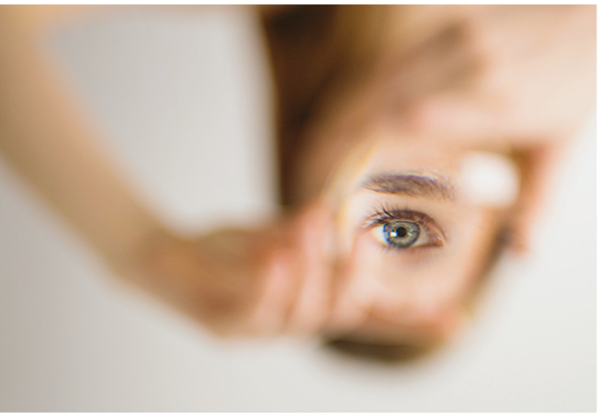The low-down on Dry-Eye and contact lenses
Do you suffer from pain, the sensation of having something in your eye, dryness or irritation, burning, sensitivity to light and redness while wearing contact lenses? 1 2 You may also notice that your vision is blurry? 1 All of these are common symptoms of Dry Eye. It may sound trivial, yet almost 25% of the millions of people around the world who start wearing contact lenses, stop wearing them due to dryness and discomfort. 3
How do contact lenses cause Dry Eye?
If you suffer from Dry Eye, you are not alone as it is a common and complex problem for many people who wear contact lenses. 4 Contact lenses change the tear film and reduce its thickness. Put simply, contact lenses break-up the tear film of the eye, and disrupt it from reforming. They also break the oil (or lipid) layer, which causes tears to evaporate. 4, 5 As the tear film acts as a lubricant, there is increased friction between the eyelid and the surface of the eye, resulting in damage. As there are not enough tears, there is also increased friction between the contact lens and the eye surface. 6
Everyone reacts differently to each type of contact lens.
It's important to know that there are contact lenses available to help reduce Dry Eyes. Speak to your optometrist about different options before you give up on wearing contact lenses. You may find that changing your disinfection solution can also help, so be sure to discuss this with your optometrist. 8
It is generally more difficult to reverse the irritation from Dry Eye than it is to moisten your eyes before symptoms occur. 8
Non-prescription, over-the-counter (OTC) drops are available to help relieve the symptoms of Dry Eye. Some of these, such as artificial tear drops, are designed to lubricate the eye and can provide relief. If you know that you are going to do something which makes your symptoms worse, such as spending time at your computer, it's recommended that you use the drops before beginning and then continue using them throughout your activity. 8 You may also find that it helps to take regular breaks if you work on a computer, as well as to limit your exposure to drafts and dust. 1
Useful tips to manage Dry Eye & Speak to your optometrist about: 1
- Changing the type of contact lens you use.
- Increasing how often you change your contact lenses.
- Changing the solution you use to clean your contact lenses.
- Using a tear supplement, such as artificial tears or ocular lubricants.
- Using Omega-3 and 6 supplements (e.g., primrose, flaxseed, fish oil or krill oils).
Ask your eye care practitioner for advice and more information
References:
- Fuller D. Yes, Dry Eye Patients Can Wear Contacts. Review of Optometry. Published 15 August 2015. Available from: https://www.reviewofoptometry.com/article/yes-dry-eye-patients-can-wear-contacts [Last accessed February 2023].
- Pucker AD, Ng SM, Nichols JJ. Over-the-counter (OTC) artificial tear drops for dry eye syndrome. Cochrane Database Syst Rev. 2016;2:CD009729. Published 2016 Feb 23. doi:10.1002/14651858.CD009729.pub2
- Igarashi T, Kobayashi M, Yaguchi C, Fujimoto C, Suzuki H, Takahashi H. Efficacy of Rebamipide Instillation for Contact Lens Discomfort With Dry Eye. Eye Contact Lens. 2018;44 Suppl 2(S):S137-S142
- McMonnies CW. Eye rubbing type and prevalence including contact lens 'removal-relief' rubbing. Clin Exp Optom. 2016;99(4):366-372
- Markoulli M, Kolanu S. Contact lens wear and dry eyes: challenges and solutions. Clin Optom (Auckl). 2017;9:41-48
- Kojima T. Contact lens-associated dry eye disease: recent advances worldwide and in Japan. Invest Ophthalmol Vis Sci. 2018;59:DES102–DES108
- Reddy SC, Ying KH, Theng LH, How OT, Fu-Xiang PK, Muhsin bin Mohamed Sikander MA. A Survey of Dry Eye Symptoms in Contact Lens Wearers among University Students in Malaysia.* J Clin Exp Ophthalmol.* 2016;7:22
- Kannarr S. Treating Dry Eye Symptoms in Contact Lens Patients.* American Optometric Association.* Available from: https://www.aoa.org/Documents/optometric-staff/articles/Treating%20Dry%20Eye%20Symptoms%20in%20Contact%20Lens%20Patients%20-%20Friedman%20edits.pdf [Last accessed February 2023].
OPTIVE® Lubricant Eye Drops and OPTIVE® Unit Dose Lubricant Eye Drops – Class B. Contains carboxymethylcellulose sodium 5 mg/ml and glycerine 9 mg/ml. For full prescribing information refer to the Instructions for use. For adverse events, report to MEAPV@abbvie.com. AbbVie (Pty) Ltd, Reg 2012/068113/07. Address: Building 7, Waterfall Corporate Campus, 74 Waterfall Drive, Midrand 1685, South Africa. Tel: 011 031 1600. Date of Publication of this material: May 2025. Promo. No. ZA-OPT-250021.






